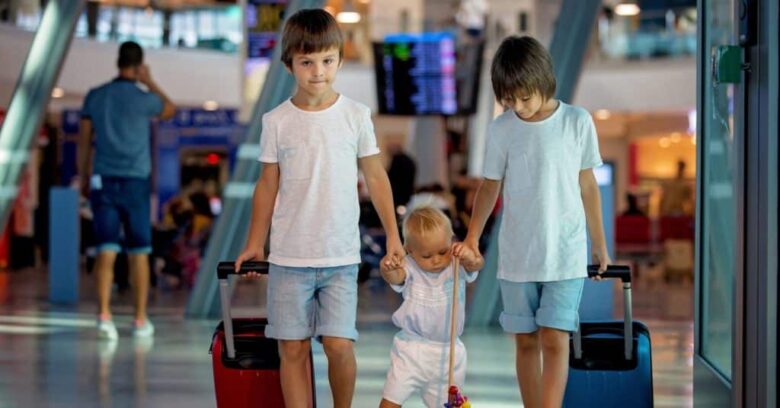Traveling with kids can be one of life’s most exciting times, but it can also be challenging. Keeping your kids safe in unfamiliar places requires extra planning and attention. Dangers can occur in places you least expect, like busy airports and tourist attractions. Whether you’re driving or flying around the world, these essential safety tips can help you keep your family safe while creating memories. With the right measures in place, you can avoid stress and focus on enjoying your trip. These 10 essential safety tips for traveling with kids are something every parent should know.
Research Your Destination before You Go:
The best way to protect yourself when traveling with kids is to know what to do. Look for family-friendly restaurants, nearby medical facilities, and safe areas where you’ll be staying at your destination. Check for health or travel alerts that could change your plans. Find emergency numbers for your area and save them in your phone. Knowing your country’s regulations can also help you avoid embarrassing situations. For example, some countries have strict rules about how children behave in public. Make sure you have all the essentials with you before you leave.
Pack a Complete First Aid Kit:
If you are traveling with children, it is important to have a first aid kit ready to go. Painkillers, antihistamines, cleansing wipes, bandages, motion sickness pills, and any prescription medications your child may need should be in the bag. In warmer areas, don’t forget to pack sunscreen, insect repellent, and rehydration salts. You can also bring a digital thermometer and some basic medical supplies, such as scissors and tweezers. These items can even save the day in an emergency.
Find a Way to Identify Your Children:
Children can easily get lost in crowded places. Give each child an ID with your phone number. Temporary tattoos, ID bracelets, or tags sewn into clothing are good options. Help older children remember the name and phone number of your hotel. Take a photo of your children every morning so you know what they are wearing if you need to. At the beach, some parents write contact information on their children’s arms with a permanent marker. Following these simple steps will greatly increase the chances of seeing each other again if you get separated.
Establish Clear Meeting Points and Safety Rules:
Agree on clear safety rules with your children before entering a busy area. Choose a clear meeting spot, such as a pond or information desk, in case someone gets lost, and keep it clear. Children should know how to ask someone in formal clothing for help. Make up stories so they know what to do if they get separated from you. Never let them go with someone they don’t know, even if they say you sent them. Repeating this important information to your children will help them remember it.
Choose a Mode of Transport that is Suitable for Your Children:
Road safety depends greatly on your destination. Ask if car seats are available or if you need to bring your own. In some countries, taxis do not have seat belts at all. Stay away from crowded vehicles and awkward vehicles. If you want more space on the plane, ask for a seat against the wall and bring something for the children to play with. Always hold hands when crossing the street, as cars in your area may drive differently. Your vehicle can affect the safety of your family.
Pay Attention to Food and Water Safety:
Children’s stomachs are more sensitive to new foods and waterborne diseases. In poor countries, it’s best to use bottled water and avoid adding ice to your drinks. If you’re unsure about the cleanliness of a food, opt for cooked food instead of raw. Bring familiar snacks so you don’t make risky choices when you’re extremely hungry. Watch for signs of food allergies when trying local dishes. Keep anti-diarrhea medication and probiotics on hand to prevent your trip from turning into a long trip to the toilet.
Book Your Accommodation as soon as You Arrive:
Hotel rooms and holiday homes often pose hidden dangers for children who are always looking for something new. Do a quick safety check: check for loose balcony railings, easily accessible electrical outlets, and dangerous cleaning products under the sink. Keep breakable items out of reach and ask for a baby gate if necessary. Cover doorknobs to keep toddlers out of the hallway. Keep a flashlight by your bedside for emergencies at night. These few minutes of preparation can prevent accidents.
Monitor Your Child Regularly Near Water:
Drowning can happen quickly and quietly, so water safety is essential. Never assume that someone is watching your child near a pool, beach, or bathroom. Avoid inflatable toys and use a U.S. Coast Guard-approved life jacket instead. Children should learn how to stay safe in the water and even take swimming lessons before engaging in any water activity. Even shallow water can be dangerous, so always keep an eye on the water. When children are near water, a moment of distraction can have serious consequences.
Protect Yourself From the Sun and Bad Weather:
Children’s skin can burn more easily than adults’, so it’s important to protect them from the sun. Apply a broad-spectrum sunscreen every two hours and after swimming. Protect your child from UV rays by wearing wide-brimmed clothing and a hat. Watch for signs of heat stress, such as nausea or dizziness. Dress in layers in cold areas and watch for signs of frostbite. If the weather is really bad, adjust your plans to prevent your child from getting sick from the heat. Planning can help you enjoy outdoor activities without getting hurt.
Plan for All Possible Emergencies:
Even with safety measures in place, emergencies can happen. Find the nearest hospital and keep your travel insurance details handy. Make copies if you lose your ID or other important documents. Make sure you can call if your cell phone goes out of service, and agree on a place to meet if you get separated. Adults should teach young children basic first aid and how to call for help. Having a backup plan can help you feel less stressed when something unexpected happens. Children will feel reassured that you can stay calm in dangerous situations.
Conclusion:
Traveling with kids takes more effort, but the experiences they gain in their lives make it worth it. Follow these 10 safety tips, and your family can explore the world worry-free. From careful planning to strict supervision, each tip addresses common risks parents face while traveling. Remember that your children will imitate your behavior, so staying calm and prepared will help them feel safe in unfamiliar places. As long as you take smart safety precautions, you and your partner can enjoy exploring the world together. Travel safely and have amazing experiences that your family will never forget.
FAQs:
1. How can I make sure I can see a lot of kids in crowded places?
Wear bright clothing to be more visible; consider baby seat belts; and assign an adult to a specific child. Installing GPS trackers in shoes or bags can increase safety.
2. How can I make sure my child’s car seat is secure on the plane?
For example, most airlines allow car seats that are approved by the Federal Aviation Administration (FAA). Place the seat by the window so that it does not interfere with an emergency evacuation. Bring the instructions with you so that the crew can check them.
3. What should I do if my child gets sick during my trip?
Contact your travel insurance provider immediately. Many insurers offer 24/7 medical care. To find a suitable clinic, contact your hotel reception and keep all medical documents in case the insurer needs them.
Is a baby carrier or a stroller better for travel in terms of safety?
It depends on where you are going. Baby carriers are better for long walks because you can keep your hands free in crowded areas. If you want a safe stroller or baby carrier, choose one with a wrist strap.
5. How quickly do I childproof my hotel room?
Bring electrical outlet covers, corner protectors, and a portable doorbell. Secure cupboard doors with rubber bands and move furniture away from windows. Always be alert for items that can be a choking hazard for young children.




